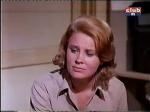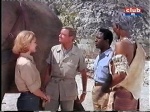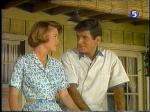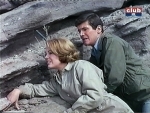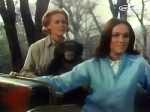My thanks to Walter, a longtime Daktari fan from the Netherlands, for sharing this fascinating article about just what Africa, U.S.A. was all about.
* * * * * * * * * * * * * * * * * * * * * * * * * * * * * * * * * * * * * * *
Animal Kingdom, USA
Out in California flourishes a wild-animal domain located just this side of Unbelievable
by Cleveland Amory for TV Guide April 1966
Hollywood these days may or may not be still the Land of Make-Believe. But it boasts at leastone place, Africa, U.S.A., which has even the “natives” rubbing their eyes. “I’ve worked here every day for a year,” Marshall Thompson the star of Daktari told me, “and I still don’t believe it.”
To begin with, like most things in Hollywood, it is actually not in Hollywood at all. It is located more than 50 miles northeast, almost surrounded by mountains, in beautiful Soledad Canyon. Here, in simulated “jungleland,” complete with “Zulu” villages, live more than 300 African, Asian and, in fact, world -wild animals-ranging from aardvarks, alligators and anteaters to Xiphosuras, yaks and zebras.

Founded by animal trainer Ralph Helfer, and now owned and operated by him in partnership with Ivan Tors (producer of Flipper), it is–now that the new acreage is operating–one of the world’s largest zoos, except, of course, that it isn’t really a zoo at all, because it is not open to the public and because a large number of its animals are never caged—even leopards and jaguars seem to roam about almost at will.
Africa, U.S.A., is the place where they film 90 percent of all the difficult animal acts you see-both in the movies and on TV. And to do these, acts has required, among other things, a totally new concept in animal training. Ivan Tors calls it “affection training.” Ralph Helfer calls it “emotion training.” Marshall Thompson doesn’t call it anything–but he says, “All I know is that every night, before 1 go home, I go around and say goodnight to my friends.”
As you approach Africa, U.S.A., you hear it before you can see it. You hear the exciting sounds, the trumpeting of elephants and the roaring of lions and tigers; the eerie sounds, the hooting of owls and the howling of wolves and coyotes and finally the enchanting sounds, the bleating of young antelopes and the chattering of baby chimpanzees. Then, when you actually come upon it, the sight is breath-taking. Off in the distance you actually see the veld—all the way from the galloping giraffes to the high-jumping kudus–and, close by, you also see what they call “Beverly Hills,” which is the residence of the animal “stars.”

Inside, in front of half a dozen floodlights, grinding cameras and sound trucks, you see a cross-eyed lion spring at a man. On another “stage”– equally surrounded–a chimpanzee is guiding a baby lion on the back of a crocodile. On still a third “stage” vu1tures crowd around while a cheetah attacks a hyena which is attacking Dina Merrill. Off in the distance, also surrounded, a rhinoceros is charging a station wagon filled with people. You’ll shake your head–and, as you do, a full-grown Bengal tiger jumps into a truck for what appears to be a coffee break with a very pretty girl named Cheryl Miller (she’s Paula, of course, in Daktari).
But the most amazing thing of all is, even after the most ferocious appearing “fights,” the animals, the minute the camera stops rolling, break cleanly and come out playing.
If you think, however, it all just happened–you have another thing coming. The telephone rang while I was interviewing Ralph Helfer. “Yes, Ivan,” he said, “I can give it to you Thursday.” He put down the phone. “Ivan asks the darnedest things,” he said. “Sometimes I think he did Daktari just to test us. Do you know what he wants this time? To have an animal crossing a river using a python for a bridge.”
After we had talked a while more, the phone rang again. This time it was a director of another show, who wanted to know if he could have a dog “kill” a lion in a fight. I told him I could,” Helfer said, putting down the phone, “but I want you to know that back of that answer was four years of work.”
I saw a scene that day—a full-grown lion fighting a German shepherd dog, Prince, Ralph’s own personal pet and the animal he prizes even more than any other of his “wild” ones. (“But,” he says, a little sadly, I had to teach Prince to be wild. I didn’t feed him and he foraged on his own to get tough enough for the job.”) “In any case, Prince brought the full-grown lion to bay in a wild, furious, growling, snarling fray. At the end I was sure that Prince would be, at least, a hospital case. Afterward I examined him, and, sure enough, he had to go to the infirmary. He had it seemed, a small cut on his left ear.”
Change in tactics

In the old days difficult fight scenes were shot either with split-screen photography—which was very expensive—or with glass in between the combatants, or by use of double. In some instances men dressed as gorillas; one famous scene used a “lion” which was actually a St. Bernard. But all of it was, generally speaking, based on the old-school “whip and chair” fear method—one perhaps best exemplified by a curious Bulgarian trainer who was recently quoted in a national magazine as saying, Most animals you got to beat to make them obey.”
Today, to Helfer and Tors, this kind of thing is not only cruel and stupid, it is also not true. Even in the “Beverly Hills” section their animals are not to be confused with Park Avenue’s pampered poodles (“If we did that, says Tors, “we’d get spoiled animals”) but anywhere in Africa, U.S.A., the use of whip, chair or any other means of intimidation is strictly forbidden. One of Ivan Tors’ rules is that, even with the older animals, every one has personal contact with a human every day. “I feel,” he adds, it’s actually a physiological process.” Ralph Helfer adds that it is also a psychological process. “If an animal has only fear of you,” he says, “you can only go so far with him, You say, under the old method, you are going to bring him into your life—or else—and he may come. He may even come almost all the way. But not actually all. He’ll keep one door locked, and someday he’s going to explode and hurt you, or even kill you. But if from the beginning you’ve always gone to him in an entirely different way, with respect and affection, he’ll finally unlock that last door himself. You never know when. With an older animal who’s had ‘fear training’ it may be never.
“When I’m asked how long our system takes, I only say, ‘Forever.’ But I do know the greatest moment a human can have is when that animal finally unlocks that last door for him. When that moment comes, the animal will do anything for you just to please you. The reward thing, the good or whatever, is only a small part of it.”

Only with the baby animals is Mr. Tors’ and Mr. Helfer’s process a relatively quick one—because, of course, these animals have never known a fear method. Actually, these animals fall under the distaff domain of Helfer’s beautiful wife, Toni. A former model, she has brought up her own baby girl, 2-1/2-year-old Tana, among the animals.
The hardest scene Mr. Helfer told me he ever had to do was a scene in the movie “The Lion.” Here the father was supposed to have shot his daughter’s pet lion, and the director wanted the lion to “die” in the girl’s arms. “On top of it all,” Helfer told me, they wanted it in a rainstorm.
“I defy anyone,” he said, “to get that scene without our kind of training. How are you going to do it? To get the lion to go completely limp, with his tongue out, with not a movement—not even an eyelid?
“I did it with Zamba, my favorite lion, but I’m not proud of it. To do it, I had to double-cross him. Before we shot the scene, I bawled the devil out of him. I told him I was surprised at him—that he was no good, that would never be any good, that he had let me down. Zamba was so hurt, he ‘died.”
An animal to be remembered
Of course, Zamba didn’t actually die—and, in time, he did get over the double-cross. But today he is dead, and, although there is a new Zamba in Africa, U.S.A., there is also, in the very center of the compound, a statue to the original. The legend is simple. “Zamba,” it says, “Friend to All.” Helfer points to it quietly. “I know it doesn’t sound right, but I got my religion from Zamba.

Besides Zamba, the cast of characters in “Beverly Hills” includes Judy, the 3-year-old chimp who is tops in all the animal kingdom in what Ivan Toors calls “human” intelligence (he makes a sharp and not entirely favorable comparison between this and “animal” intelligence); Clarence, the cross-eyed lion (“He really does see double. We took him to the top eye doctor in the world, but nothing can be done about it”); Bruce, the ocelot in Honey West (“he’s actually very gentle, but he can act fierce enough to make the humans around him look brave”); Patricia, a 450-pound Bengal tiger, who starred in Disney’s “A Tiger Walks;” Bruno, a 7-foot, 700-pound black bear, perhaps the biggest “working” bear in the world and yet so gentle children can ride him; Sir Tom, a mountain-lion veteran of at least 60 movies; Raunchy, a 250-pound jaguar (“They said you could never train a jaguar. We didn’t—he trained us”); and, finally, Big Mo and Margie—Big Mo, a 4-ton, 50-year-old elephant who is the largest, strongest, and certainly the best actor in elephant history, and Margie, who is a small 7-year-old pachyderm who can do everything but talk.
Once in a while ex-pets are taken n despite both Helfer’s and Tors’ strong opinions on wild animals as pets (they are 100 percent again it—“it’s all affection and no respect”), they turn out to be fine performers.
Not long ago, a new director on the Daktari set went right up to a lion. “I’m not afraid of him,” he said. Marshall Thompson grabbed the man. “You should be,” he said, pulling him back. “You don’t know enough not to be.” Helfer puts it this way. “Lack of fear is just as dangerous as fear itself—which is, of course, lack of understanding. And the moment you understand, you can’t fear. When we have a guest star in Daktari, we tell him three things: Don’t make a sudden movement, don’t make a loud noise and don’t approach the animal until someone who knows more than you do has ‘read’ him and knows what mood he is in.”
Training for tarantulas
Both Helfer and Tors have not only gone all out in their new beliefs (“Even our tarantulas,” they point out, “get affection training”) Then, too, they have even challenged what has gone down in animal books as going “against nature.” Tors has, for example, hundreds of times, with no difficulty raised a ‘killer” with his natural prey–a tiger with a fawn, for one instance—and he is even now engaged in proving that “killer” whales are not necessarily killers at all. “I told my scriptwriter just one thing,” he says. “The whale is Captain Dreyfus and you are Zola.”
Tors’ philosophy
But there is no question that Tors feels he is doing something far more important than any one television show. “I was born a mammal,” he says, “and now in a big city 1 have to live like an insect. In a car I feel like a bug. Even on a freeway I’m just an ant in a long line of other ants. In New York it may be more like a beehive, but it’s all wrong. We live a phony existence. We don’t understand life and death. We fell out of rhythm with nature. We pretend we don’t kill, but let others kill for us.”

I asked Mr. Tors if he saw any hope. ”Well,” he said, “Ian MacPhail, the campaigns director of the World Wildlife Fund, told me that three years ago, when a safari started out from the New Stanley Hotel in Nairobi, the natives would cheer. Now they jeer. And right here in our country there’s beginning to be an entirely different feeling about everything to do with animals–from hunting all the way to laboratory animals.”
I also asked Mr. Tors what was his own favorite animal. “Cheetahs,” he replied. Finally, I asked him what was the most difficult animal to train. He smiled. “Your own house cat,” he said. “He has the most’ independence–and integrity.”
The acid test of the effectiveness Of the Africa, U.SA. training came one dark and stormy night this winter.
Thirty inches of rain, the heaviest downpour in Los Angeles history, washed out a flood-control dam, and before it could be restored, a second storm dumped 14 more inches, within 24 hours, on the area.
The entire reservation was flooded–engulfed by waves with 8-foot crests and with power enough to splinter barracks into matchboxes, to overturn a 45-foot trailer truck, to pick up 1000-pound animal cages as if they were made of cardboard and carry them off down a river which had become raging torrent. So amazingly quickly did it all happen that Ted Derby and Frank Lamping, two head trainers, were both carried off nearly half a mile down the river before they were rescued. Once back, they, Mr. and Mrs. Helfer , Joyce Freeman, the general manager and other employees had but one purpose–to save as many animals as they could.
At first their task seemed hopeless. Africa, U.S.A., had become a underwater arena full of confused, fear-crazed animals. In a few minutes, years of work were, it seemed, to go literally down drain.
But then, that dark night, as they had done every day for so long under happier circumstances, they approached the animals. Toni Helfer made for the animal nursery and opened the door. The water-soaked, half-drowned, terrified young animals suddenly stopped their frantic fighting of the water and each other and fought to get to her. Carrying some, leading others and calling still others, she brought every single one to safety.
Meanwhile the others approached the older animals–the lions, tigers, the leopards and the jaguars. Frightened as they were, the animals did not forget their lessons at Africa, U .S.A. There was no time to tie and pull them–they had to come, or else. Each sight of these huge animals being taken to higher ground, and safety, was more remarkable than the one before–a keeper, Jack Silk, carrying a cheetah piggyback across the river, literally swimming under him; 90-pound trainer Harley Tony alone carrying a 115-pound python, a snake that normally takes three men to lift. But perhaps the most amazing sight of all was Big Mo. For one of the trainers, unable to budge a cage sliding into the water had suddenly thought of the elephant. He had gone and untied him. Without a word of command, Big Mo went down to the river and set himself in position. A rope was put around the cage—and Big Mo pulled it to high ground.
In all only four animals were lost—a new lion which had not yet had affection training and refused to leave her cage; a rare eagle from Pakistan, which had drowned, and two wolves which became so terrified nothing could be done to save them. A third wolf was, at least, freed frorn its cage. However, when a sheriff saw it swimming to freedom across the river to the wrong side, he refused to let it go. “I cannot allow it,” he shouted, and pulled out his gun. Immediately one of the trainers dove into the icy water and put his arms around the wolf, foiling the shooting.
Nowhere though, that night when the storm subsided and they took stock, could anyone find Bruno. The 700 pound black hear was gone. Frantically Tors and Helfer advertised on the radio and television not to shoot him–that he was affectionate. Two days later, to the amazement of all, Bruno casually ambled back into camp and headed for his cage. He seemed none the worse for whatever experiences he had had—only tired–and to this day no one knows where he had been.
“My guess,” says Tors, “is that he decided it was time for a personal appearance tour.”
 Click to Tweet & Share: The story of Africa, U.S.A. and its proprietors, animal trainer Ralph Helfer and Daktari producer Ivan Tors http://wp.me/p3hKG3-cq
Click to Tweet & Share: The story of Africa, U.S.A. and its proprietors, animal trainer Ralph Helfer and Daktari producer Ivan Tors http://wp.me/p3hKG3-cq
![]()
 Are you a fan of Daktari?
Are you a fan of Daktari?
Send an email to daktaritvshow@gmail.com
to subscribe, and never miss a post!
Follow Susan on Facebook and Twitter
Listen to Susan’s music Read Susan’s other blogs: Louisa May Alcott is My Passion and Be As One: Living Life in a Single Flow



















